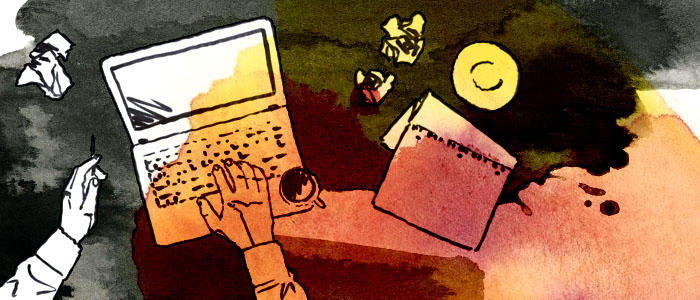Illustrated by Fahren Feingold
When I was a teenager, I tore through Woodward and Bernstein’s All the President’s Men and The Final Days like a fisher cat attacking that porcupine who loves corn on the cob.
Then I devoured all of Woodward’s solo work, marveling at his cultivation of sources and formidable interviewing ability. When I decided at 15 that journalism was my calling, like many aspiring reporters, I set out to become him.
But I did not become Bob Woodward.
I became a managing editor for original blog content campaigns. I’m still a reporter at heart, though, and the interview skills I developed back in the day remain a big part of my approach to producing quality articles for businesses looking for more web traffic – and more potential customers. Here’s how to interview someone so that the process strengthens your posts with authority and expertise.
How to Interview Someone for an Article: 5 Best Practices
Interviews are demanding, and there are multiple deciding factors in whether you obtain the information, quotes, background, perspective, and context you seek. Start with these five best practices to put yourself in a position to succeed. Above all, be sure to balance your professional due diligence with being your personable self.
1. Research Your Subject
Like many other activities, producing content sees most of the job accomplished behind the scenes – long before a post goes live.
Many readers don’t realize just how many parts and how much labor goes into those compelling blog posts you put out every week, do they? They don’t see the cutting and trying, the fits and starts, the exhaustive research. The moments when you fall to your knees and beseech your preferred higher power to deliver you from this infernal wretch of a profession.
Nor will your interview subject, but they will appreciate your preparation, trust me. The actual conversation – and the best interviews are just that – will be smooth and almost anticlimactic. Your hard work will ensure your own confidence going in and allow you to ask things no one else has. Read everything you can about your subject – including other interviews – and formulate questions that will contribute to a sustained and stimulating exchange.
Remember: You asked them to dance. It’s your responsibility to take the lead.
Takeaway: There’s a reason they call it work. Know what you’re talking about … about who you’re talking to.
2. Gear Up
Imagine, if you will, the worst nightmare you’ve ever had. Now multiply it by 10,000. That’s what it feels like to have an awesome interview with a subject and then find that you botched the recording somehow.
In general, the interviews you conduct won’t be for the purposes of Pulitzer-nominated journalism, so state laws about recording people over the phone are less important in this context. Still, you should always inform your sources that you’re recording them.
Depending on your circumstances, double-check your mikes, phone lines, cell reception, cameras, and software in the hours leading up to the interview. Check the ink in your pen and the paper in your pad. If you’re using an app for recording conversations on a smartphone – my current favorite is the reasonably priced and reliable TapeACall – test that bad boy like you’re an out-of-touch department of education: frequently.
Takeaway: Make certain you have the right equipment in place – or prepare for a lifetime of anguish and regret.
3. Have ‘Soft Ears’
“You know what you need at a crime scene? Soft eyes. If you got soft eyes, you can see the whole thing. If you got hard eyes, you staring at the same tree missing the forest. Soft eyes, grasshopper.” – Det. William “Bunk” Moreland, The Wire
All right, so only a really bad interview could be described as a crime scene, but Bunk’s point stands. For our purposes, though, you’ll need soft ears instead of eyes. This way, you can hear “the whole thing.”
Don’t get so wrapped up in sticking to the script – i.e., insisting on asking each question you’ve prepared no matter what – that you miss out on what your source is actually trying to say. Being more open to the flow of the conversation will help you create a natural rapport and give you a better chance at walking away with that you want: insight and analysis for your post.
Takeaway: Within reason, and while maintaining control of the interview, if a source leads you down a rabbit hole, don’t be afraid to follow them! You never know what you might find out.
4. Leave Your Ego Behind
So, I just discussed “being more open to the flow” and now I’m talking about leaving your ego behind. No, this isn’t a Theravada Buddhist meditation disguised as a B2B blog post on how to interview someone for an article. Hear me out.
The majority of content producers don’t need to be told that an interview isn’t about them, but how many times have you watched Charlie Rose railroad a subject or read a long-form magazine article where you learn more about the reporter than you do the personality he’s profiling?
In general, let the subject do 90% of the talking. Yes, that percentage is exact and the result of a scientific formula. Don’t interrupt. Don’t push your own agenda. Don’t talk about your personal life unless they ask. Don’t brag about who else you’ve interviewed. Don’t go on and on for 15 minutes outlining the scope of your entire article.
Takeaway: You can shine when it’s time to write – or when somebody interviews you. For now, let your subject speak!
5. Make Sure Your Product Is Ethically Sourced
Again, this isn’t something most writers need to be told, but don’t skimp on accuracy and attention to detail. Transcribe your interviews faithfully and don’t quote your sources out of context. Represent them as you’d want to be represented in an article that will likely live online until the aliens attack. Don’t embarrass them.
This is of particular importance when you’re interviewing a client to capture their voice.
If you need clarification or find upon further review that some information they provided is outdated, circle back for a follow-up, if necessary.
Takeaway: If you misquote or misrepresent a subject, you’ll quickly find that it’s your reputation at stake – not theirs.
Knowing how to interview someone for an article is a valuable skill for content producers. Sources can fill in gaps, add color, and lend your articles an air of authority. Although the process is fairly intuitive, these best practices will help you avoid those always-fun awkward silences and even more awesome burnt bridges.
Do you use interviews to bolster your business blog content? Any tips, tricks, triumphs, or horror stories to share in the comments?





